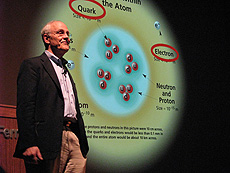Nobel laureate David Gross discusses impact of particle physics
 |
| In a public lecture Tuesday night, Nobelist David Gross explained how particle physics can help us uncover the universe's longstanding mysteries. Photo: Joseph Piergrossi |
David Gross, 2004 Nobel laureate in physics, took a large audience in Ramsey Auditorium on a wild ride Tuesday night, explaining connections between the Standard Model and the mystery of the origins of the universe in a nearly two-and-a-half hour presentation.
Gross's lecture focused on the role particle physics plays in our knowledge of the universe. He carefully explained each of the known particle families and used his explanation of the Standard Model to show concepts of symmetry breaking and the Higgs boson, supersymmetry, superspace, unification and the unanswered questions these concepts pose.
"We have an island of knowledge in a sea of ignorance," he said, referring to a cartoon showing stick figures surrounded by and pushing back on a black cloud representing the unknowns of the universe. He told the crowd the best questions in physics come from where the stick figures were pushing.
Gross also gave a rundown of evidence for major theories in physics, such as string theory, making a case for each based on what has been learned from Fermilab, CERN and other laboratories in the past half century.
At the end of the lecture, a young boy asked Gross a question about the role of dark energy in the universe.
"We'll know much more once you get out of graduate school," he assured the boy with a smile.
"As scientists, we have a responsibility to tell the public what we are doing," Gross said at a reception following the lecture in the Wilson Hall Atrium, "especially since all of this is just human curiosity."
—Joseph Piergrossi
|